There are many popular images of Tokyo, but extreme poverty generally isn’t one of them. In the east of the capital, however, in an area once known as Sanya, that’s exactly what you see.
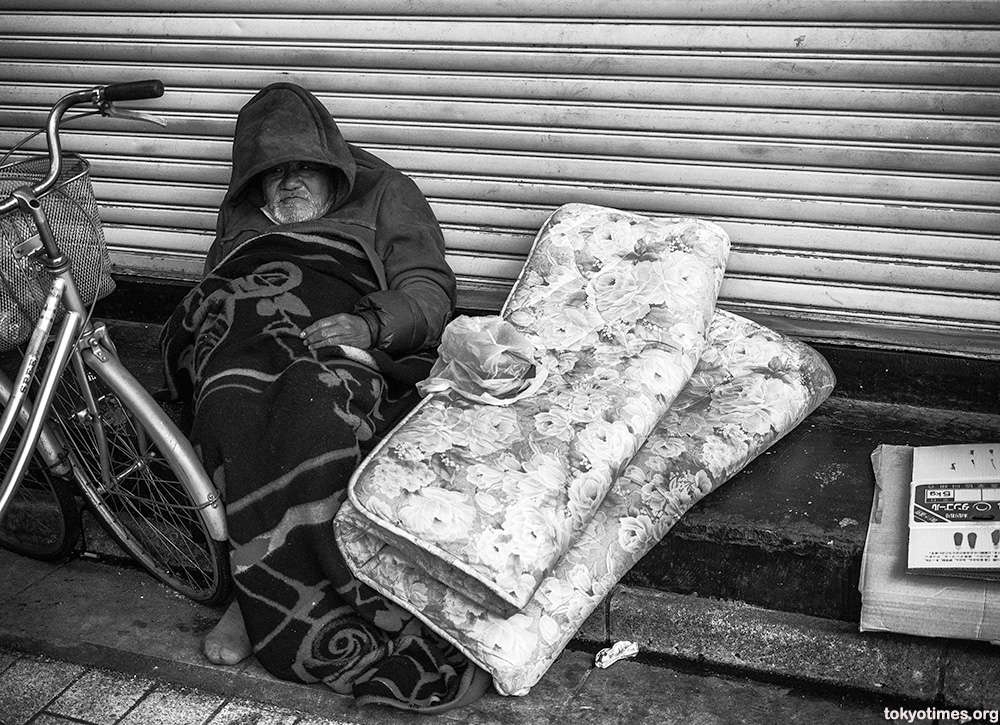
Photographs from Sanya have appeared on Tokyo Times before, but at the time I was under the impression that it was home to a large population of day labourers and the desperately poor. An equally destitute little sister of sorts to Osaka’s much larger, Kamagasaki district.
But I was wrong, at least in regards the work aspect, as it seems there simply aren’t any jobs to be had anymore. The gradual ageing of those who scratch out an existence in the area means there’s not much they can physically do, so instead the men must attempt to get by with what little money they may be entitled to — or at worst with whatever handouts are available.
Thankfully there is at least a small clinic run by an NPO. A place where the men can get help, as well as help out.
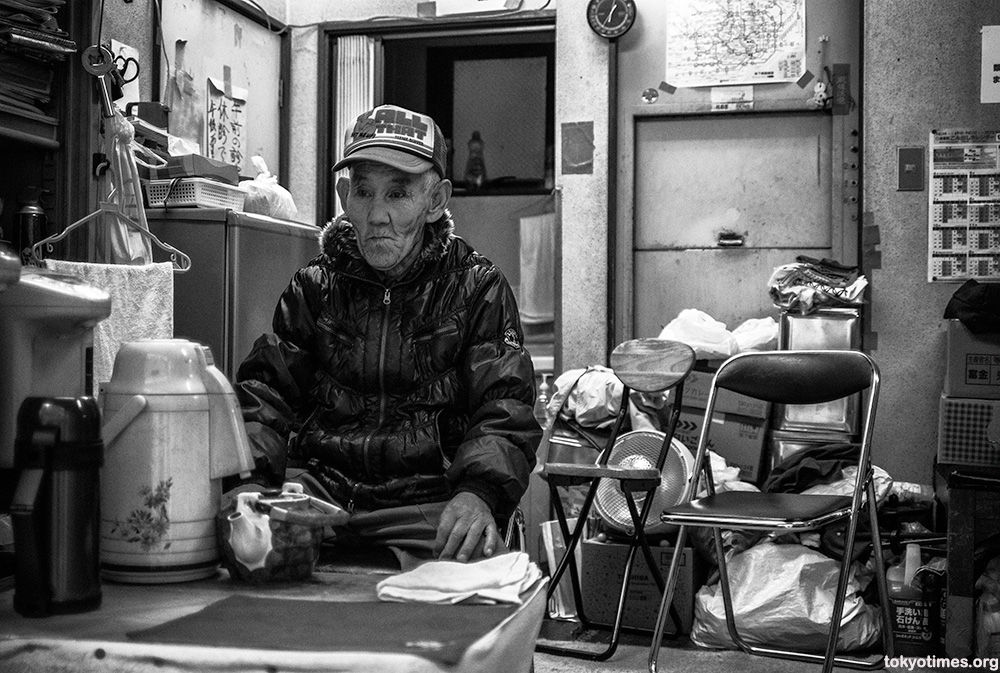
For those with the means, cheap accommodation can also be acquired. Wretched looking rooming houses that despite their obvious squalor, are clearly a blessing for those who stay in them.
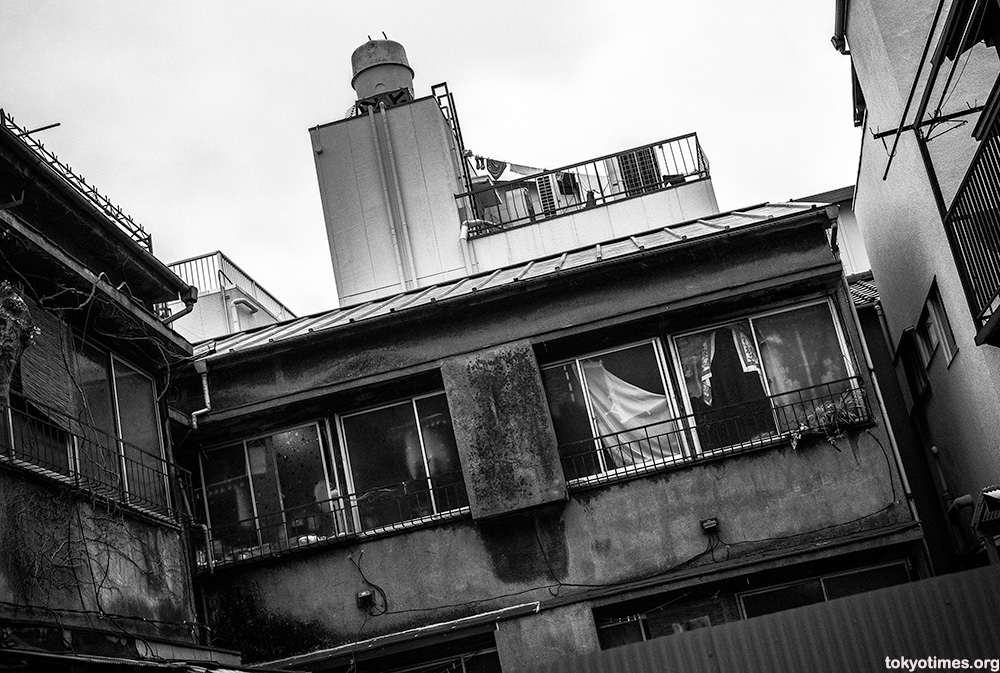
Also there are some cheap and basic facilities dotted about.
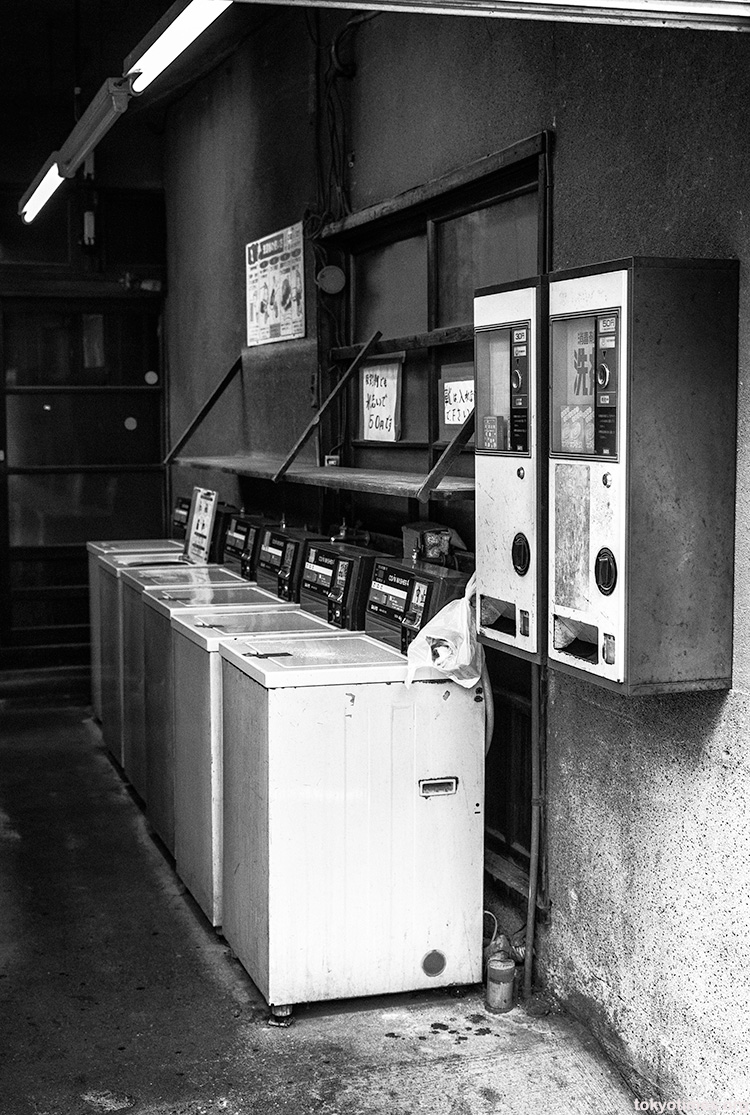
But primarily it’s a life lived — in one form or another — on the street.
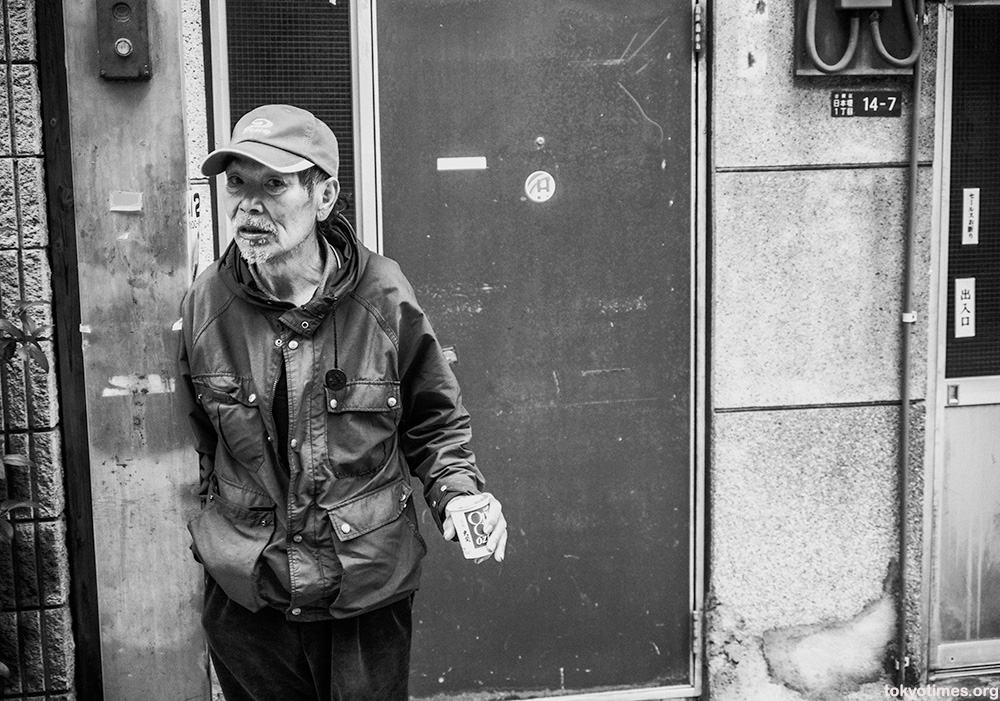
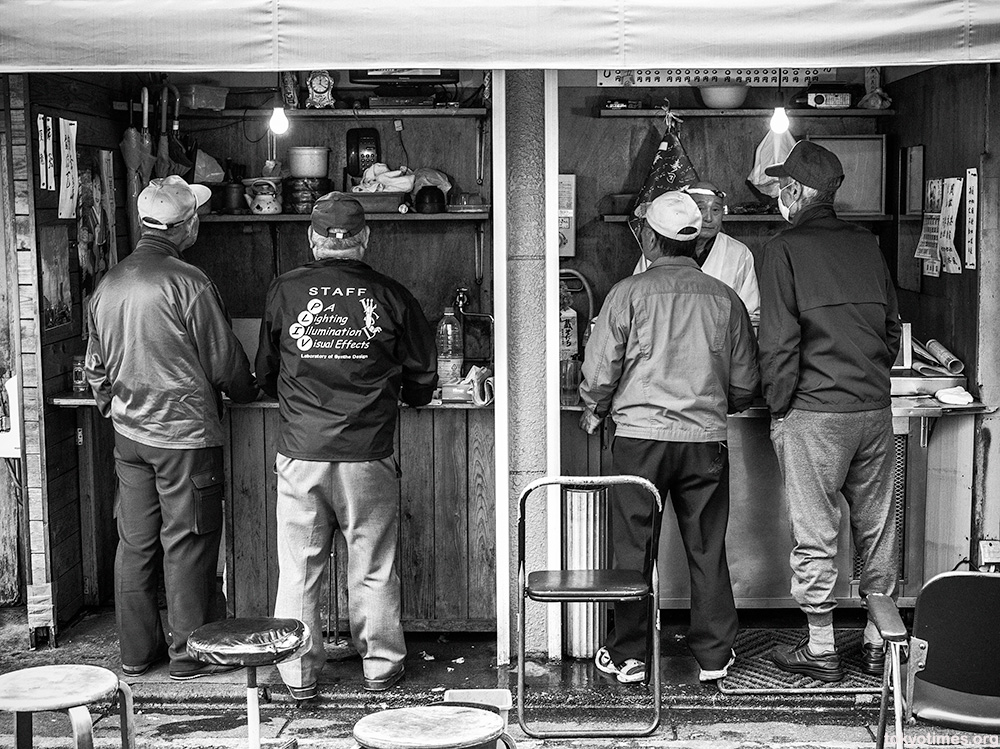
And quite understandably, drink is the only real means of escape. The cheaper and stronger it is the better. A road to oblivion that starts early.
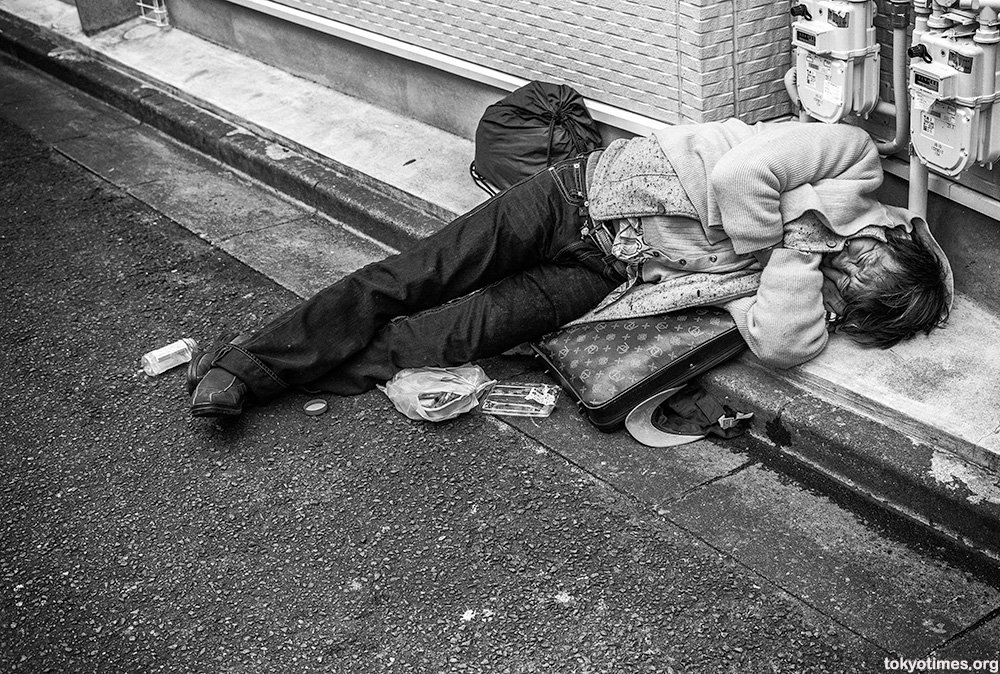
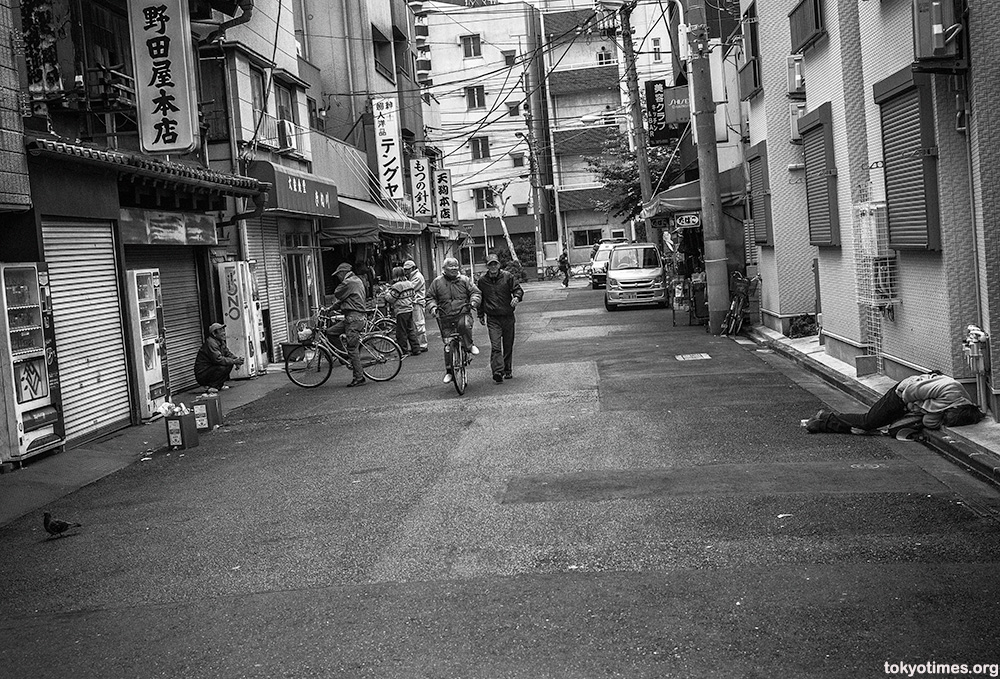
Meaning that by the time noon rears its heavy head, things are already getting ugly. Resulting in scenes that in Tokyo, during the middle of the day, are really quite shocking.
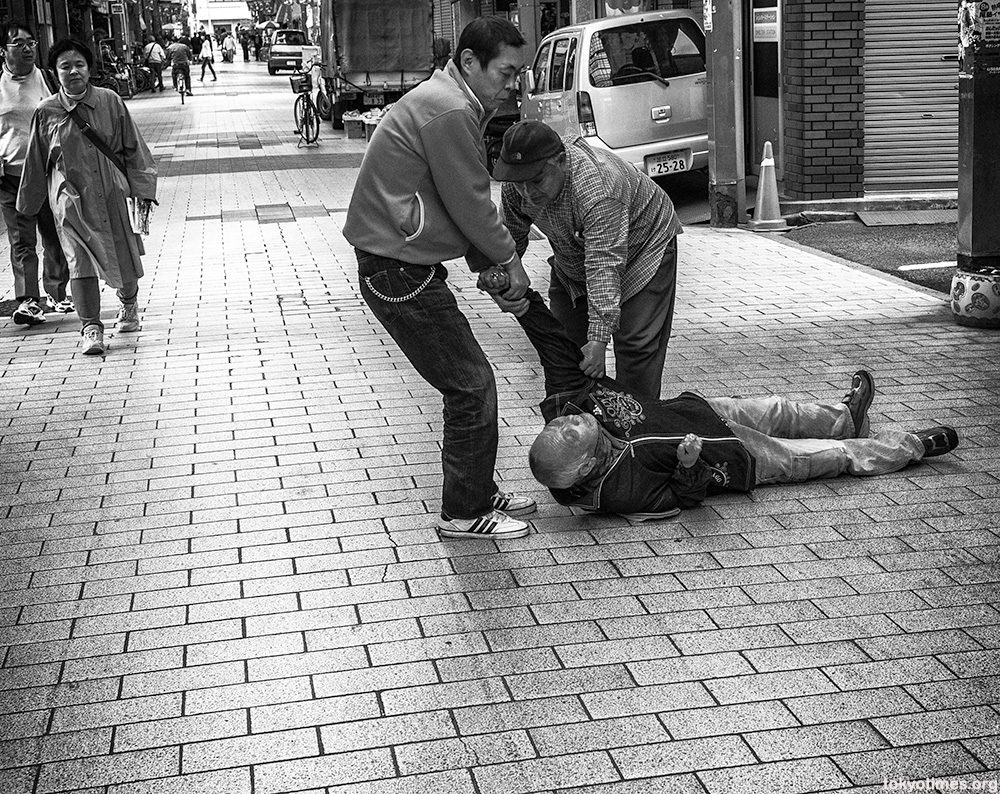
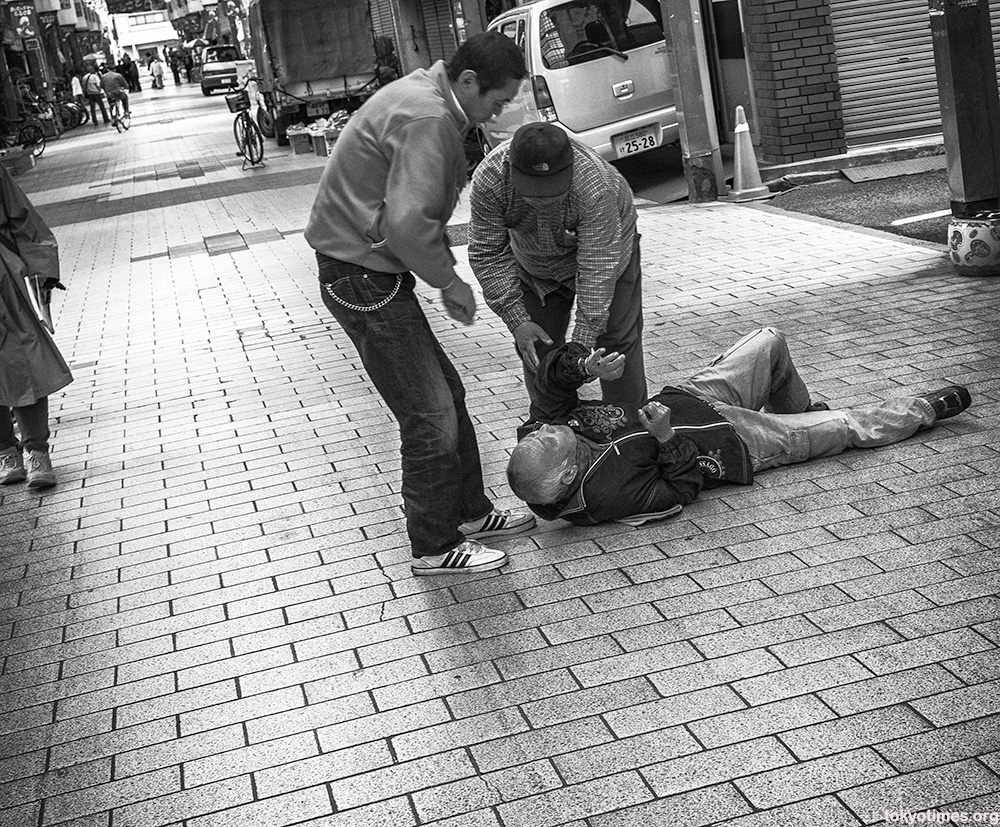
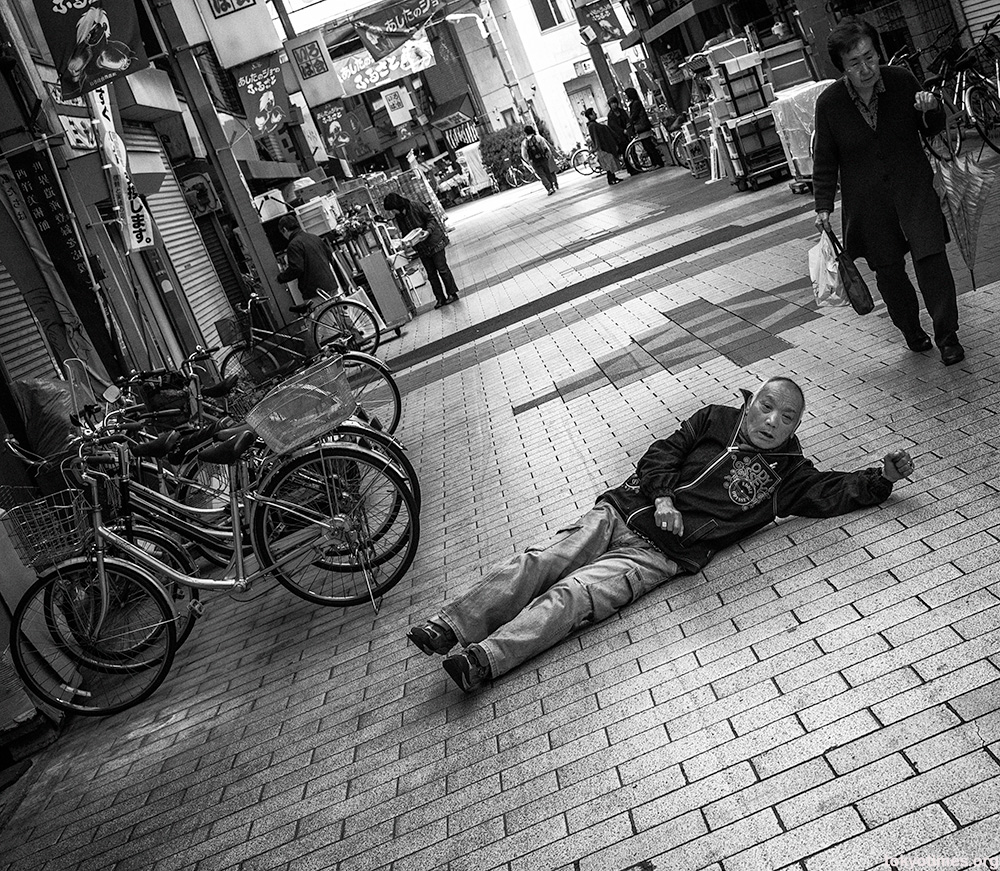
Yet such episodes sadly aren’t unusual in Sanya. Quite the opposite in fact. An element I’ve tried to capture by taking the photos on just a regular, random day. All of them shot within an hour, within an equally narrow radius. Not as a means to preach. Or to judge. But simply to document.
Chris says
Where is this located? Taito-ku? Or Chiba? Any chance at a map link?
Lee says
It’s Taito-ku. Simply head south from Minami Senju station, and you’ll hit Sanya. You won’t miss it.
Marc says
I think this is near University of Tokyo. I recall riding through this area a few years ago. Similar area just about 1/2 mile west of the main train station in Nagoya.
Kuujiryo says
When I went to Japan, I explored Nagoya when I had some free time. I came across sectioned off areas with some form of street barricades which seemed to seclude junk from other areas, but upon closer inspection there was old bedding and clothing laying around, and a few people sleeping there. I really had never seen anything like it before.
Lee says
There are quite a lot of sights like that these days. At least in Tokyo anyway.
Not really near the University of Tokyo Marc. Or a least I don’t think so. It’s not far from Minami Senju station.
johnny says
the black and white effect make it look worst.
Lee says
It had to be black & white. Colour just doesn’t seem right.
Hans ter Horst says
Impressive work Lee; quite shocking too as it is so different from the image of Tokyo most of my friends have. I cannot help and compare this reportage with the photo of the extravagant Skytree of your previous blog post. As I understood it, the Skytree is meant to revive the poorer areas of Tokyo. I wonder if all that tax money spent on it will ever reach areas like Sanya.
Lee says
Thank you.
Yes, it’s a world away from the usual images of Japan. Even though I know what to expect now, the place still shocks me. It doesn’t just feel like another city, but another world almost.
As for Sky Tree, I reckon very little of the surrounding area will benefit. As I alluded to in the post, most people will probably visit the tower and its many attractions, and then simply leave. It’s hard to imagine many of them spending any time, and more importantly money, outside the confines of the tower.
jb says
Just want to remind everyone here that just because there is a Sky Tree…doesn’t mean that it comes at the expense of others. The economy isn’t a pie. Ones wealth doesnt hurt another. Rather wealth means that person served more/better.
Ted says
I live currently in Sumida near the Tokyo Sky Tree and soon will be temporary moving even more north towards Adachi north of Kita-Senju.
Before I was living in Bunkyo. What I can say is that the North of Tokyo both West and East is the true Tokyo. Sumida is not bad at all and the Sky Tree does made the city blossom a bit more. Its the people that are not really blossoming. Japan is a country of many contradictions.
As a westerner living here is both a blessing and a nightmare. First off, I hardly speak a word of Japanese, which makes it extremely difficult to communicate on a daily basis for the most simple matters. Before moving to Tokyo couple months ago, I was living in Shizuoka which was for me the blessing side of Japan. People are more open as soon as you get out of the city.
Tokyo is not that different from any other major city in the world ( I have lived in London, Paris, Barcelona, New York, Melbourne). People want what a city can offer, but it comes at a high price both financially, physically and mentally. Depending on your job, if you earn a medium income or less, life is simply tough.
I now realize why I don’t like living in the city, but many people are unable to move out that easily. I have don’t hold any responsibility to anyone to move.
To close, I would say that Tokyo is definitely one of the safest major cities I have lived. You hardly see homeless people doing drugs in public. And hardly will they ever harass people.
Btw, great documentation 😉
Reality in Japan says
You live in a nice area and are moving to a nice area. There’s a big difference between Kita-Senju and Minami-Senju. I’m staying in a cheap hotel in Sanya right now and have been dropping in since 1993.
Leonardo Ito says
Quite shocking indeed. I’ve been to Tokyo a few times, but never really found myself facing this kind of situation. What are those two guys doing to the old man? As far as I could tell by looking at the pictures, are they stealing from him?
Lee says
It is. There are an increasing number of homeless in Tokyo, but certainly sights like this aren’t what visitors usually see. Or what most Tokyoites see to be honest.
Nah, they were dragging him out of a bar because he was too drunk and aggressive. We walked past later and he was back inside, but asleep on the floor…
Reality in Japan says
They are helping him.
Emily Marilyn says
I lived in Fukuoka for almost 5 years and never saw homeless until I visited Osaka yet only noticed a handful in a main subway underground. It’s not the typical Japan one thinks of. Curious, what is happening to the elderly man on the last few photos? Stuff like that just breaks my heart.
Lee says
It’s not, but it’s definitely there, especially in Tokyo and Osaka. A situation that’s clearly getting worse too. I’ve noticed a marked increase in the number of homeless over the last decade or so.
The old man was being dragged out of a bar. He’d had way too much to drink, and was also very aggressive. An especially grim sight at lunch time…
Reality in Japan says
Happens all the time. The guy is drunk and is being relocated.
Don says
It’s really strange, we were there 16 days and spent time in Tokyo, Osaka, Kyoto, Kobe, Takayama and Ito – and I saw less than a handful of homeless and never anything like you’ve documented here. What I did see, is a lot of the signs of the problem, just not the people. Much like Austin, it appeared a good number of the people in this position were being discreet for one reason or another. Around here, it occasionally seems to be embarrassment, but more often seems to be about privacy and protecting their meager situation.
The end result in both places seems to be that we lose awareness and any respect for the human condition – we become complicit in perpetuating the problem. It’s hard to know what we need to do culturally, but we have to figure it out and take action or it’s going to get worse.
Lee says
Yes, I’ve no idea what the solution is either, but like you say, it’s only going to get worse. Some parts of Tokyo are definitely worse than others, but over the last few years I’ve seen a growing number of homeless in all parts of the city, and not just places such as Sanya.
Emily Marilyn says
Incredible photography Lee. Really stirred up a lot of emotions.
Lee says
Thanks a lot Emily. They certainly aren’t nice images, but I genuinely believe they should be seen, especially as it’s a side of Tokyo that rarely gets any coverage.
Joshua says
I stayed in Minamisenju for a little under a week last year, and remember passing by that place in the 6th picture with the men standing at the counter. Looks just like it did then, a bunch of men standing around, chairs and stools strewn around the street. Do you know what that place is? My first thought was a restaurant of some kind, but maybe not?
Lee says
It must have been a strange place to stay, but the cheap (at least for Tokyo) land prices makes sense for developers and tourists alike. It makes for a very unusual mix though that’s for sure. Did you know what to expect before you arrived?
It’s a bar, basically. I think some small dishes are available, but cheap booze seems to be the main focus.
Reality in Japan says
I do. It’s a cheap bar and is already open at 8:00 am. I usually stay in a hotel just across the street. 3,000 yen a night.
Rafael says
This is heartbreaking. Not the usual image of Japan that people are used to seeing.
Lee says
I agree. And no, it’s not. Not by any stretch of the imagination. Probably not one Japan would want to be seen either. But however much it may be ignored, it’s a problem that sadly won’t go away.
Willy says
Heartbreaking indeed. I wish I had a solution. Or someone had one.
Its everywhere, not just Japan.
Lee says
That’s very true. As shocking as these images are for Japan, the situation is a lot worse in many other cities…
ameiji says
Thanks Lee. That’s one impressive reportage.
Lee says
Thank you very much.
Jeffrey says
Poverty and homelessness have become increasingly visible in Japan over the last 15-years or so. I think a while back on a related post I’d told you that I’d recently finished “San’ya Blues.” A fascinating but depressing book. The work is gone for these men and not likely to return.
http://www.cornellpress.cornell.edu/book/?GCOI=80140100738020
The Central Park area of my “home town,” Nagoya, is now full of blue tarp shelters. It was quite shocking to see the change over time. I don’t know of anywhere in Tokyo where it’s quite the same – so out in the open. Sakae is the main shopping district of Nagoya. Though no where as tony, imagine the same thing on the Ginza or even Shinjuku Gyoen.
Lee says
You did. A book I’ve still not got round to buying…
Like you say, the number of homeless has noticeably increased over the last decade or so. A trend it’s very hard to see changing too.
That is shocking about Nagoya. There are a visible number of homeless in the likes of Yoyogi Park, but not as obvious as the scene you describe. Very sad.
Miguel says
This is an impressive and very unusual slice of life from Japan , the last pictures are very heartbreaking , your text perfectly fit the whole reportage.
Lee says
Thank you.
robashito says
As a kid growing up in Tokyo – born in 1968 and officially moved out in 1991 – you really didn’t see many “homeless drunks” out in the mass public….. but that totally changed once the bubble popped, ….dramatically. Don’t get me wrong, you always had your drunks during the wee hours of the night, train stations and seedy areas of the town but now it’s a sad new version of despair, loss and oblivion that can be found without much looking. Sadly, many comedians referred them as …”Reggae Oujisans”
Lee says
The numbers have noticeably increased in the time I’ve been here, so the difference from when you were growing up must be huge. There’s sadly still not much in the way of sympathy either…
robashito says
…. yes, tough times and destitution indeed.
Be well Lee. Love your work.
Bernat says
I heard about Sanya before… but I didn’t know I’ve had my hotel in Tokyo for 2 weeks in there. It’s really depressing. My hotel was in front of a place where every morning it had a lot of people waiting for something… maybe it was Sanyukai? (after checking it, yes, I had Sanyukai in front of my hotel)
I will always remember the sight of their eyes… empty eyes. Maybe they thought I was like going to the zoo, until they get used of me and saw I wasn’t judging them.
Multiply the feeling you have seeing these shots by 2 or 3. Depressing doesn’t describe well the sight… Sanya should be the word used.
Lee says
Yeah, it’s a shocking place. Hard to imagine it’s in a city as prosperous as Tokyo, isn’t it? I can only imagine how strange a hotel it must have been to stay in…
Carrie says
The really is heartwrenching. When I went to visit my brother last year he took me to one of the streets where the very poor and homeless were, so I would know that there was a darker side to Tokyo. I’m not sure, but it may have been this place. Later inthe trip an older woman in very very dirty clothes (who most certainly looked like she was in need in some way) approached us on a train platform to say hi and that she used to work on an American military base and was wondering if we were American. Her spontaneous kindness was so genuine and warm. I wanted so badly to help her in some way, but was afraid I would offend her if I had offered unsolicited money or assistance. I’m so ashamed that I didn’t throw caution to the wind and asked her to come have a meal with us or at the very least given her some yen. Seeing your pictures reminded me of her and wondering where she is now and if she’s okay.
Anonymous says
I don’t think taking pictures of him like this would make things any better. If anything, it would humiliate him further. :\
person says
BUMP
Hans Gruber says
Actually, the poorest section of the big cities and even the countryside in Japan -including these pictures, are not what is normally defined as bad or poor sections by any standards. If you go to the United States, in any city one can see whole section of extreme poverty and social decay, not to mentioned that if one compares to 3rd world countries this place looks like a museum. If you think that I exaggerate just open a google street view and look and compare, contrast.
Lee says
That’s a fair shout. In comparison to some — or more accurately, many — countries, areas such as this are relatively ok. But relative to Japan, and in particular Tokyo, it’s bad. And even if the surroundings don’t appear too unpleasant (and to be honest they aren’t), people living on the street in abject poverty can can never be deemed acceptable. Something that is even more striking in a city as affluent as Tokyo.
Martin Schroder says
Quite enlightning. Iam planning to go to japan from N.Z. early next year so thought i would look more into the ‘other side of the tracks’ .Will try to seek out thesae parts so to show my children .
Thanks
Lee says
It’s not a pleasant place to visit. Thoroughly depressing to be honest. But it is arguably just as much Tokyo as the bright lights and busy streets.
Jackso says
Are all the people old?? is there any young people there??
Lee says
Not really. Pretty much all men, and all getting on a bit. That’s a big part of the problem. It used to be place for people to pick up a day’s work, but now the vast majority are too old to be doing the physical labour that was once on offer.
lloyd says
Thank you / sooomuch!!!! / this is no easy look / but love for all of humanity / never is. I lived in Osaka in the 80’s / an arrogant / boom time for Japan. I knew such places existed / I use to visit / walk through them on purpose / stopping – befriending – having a drink with those who wanted to question the Guyjein / I dont know why maybe to remind myself the world is complex / maybe because I needed a more honest connection to the world vs the artificial beauty that is part of the Japanese culture and way of life. It seem though / over the years things have become worst for those described as “down and out” . . . .
Lu says
Are these native Japanese or migrants from other countries living in Japan?
Lee says
Native Japanese. Or at least the vast majority are.
person says
Did you actually take the time to speak to any of these people or at least ask them if it was ok for you to put these pictures of them online?
Lee says
Some I spoke to, yes, and over the years I’ve spoken with many in that area. I also didn’t disguise what I was doing either. But no, I didn’t ask if I could use the photos.
I’ve been through this issue countless times, and it never gets resolved. Some people think it’s wrong to take such pictures. Even any pictures of people in public at all.
Some people, on the other hand, don’t see it at that way, and obviously I’m one of those. I photograph all manner of people, from all manner of backgrounds, and in all manner of situations. I honestly don’t see why I should photograph some people, but not others.
Oliveira Leonessa says
IN SHOCK! STUNNING! I visited Japan last year, May 2019. I went to the Kyoto region. The most beautiful place I have ever visited in my entire small existence. I always wondered what the real problems of this beautiful nation would be. But I confess that I was not prepared for this! Sanya is the extreme of human accommodation and political devotion, given that Japan is an economic power. These images embarrass Mr. Abe and Mr. Naruhito. I am not a moralist, Brazil has problems, maybe even more serious! However, we are not yet a power, and we fear more than 700 thousand km2 of borders, with several rooted historical problems such as corruption. And I feel a complex resistance even on your part in making the material, because it is very superficial. Without criticism I say, just watching. The government does nothing ?! Such is the problem with separated, single or widowed parents: discrimination and isolation. These images seem to have been re-edited from the film: Tomb of Fireflies! [Hotaru no Haka] SAD to see these images in Japan! I thought these images were unique to Brazil. Lee san estas imagena reflects the wrong way in which Japan treats, unemployed and poor elderly, children in public shelters, single parents, women who are bullied or harassed.
IN SHOCK! STUNNING! I visited Japan last year, May 2019. I went to the Kyoto region. The most beautiful place I have ever visited in my entire small existence. I always wondered what the real problems of this beautiful nation would be. But I confess that I was not prepared for this! Sanya is the extreme of human accommodation and political devotion, given that Japan is an economic power. These images embarrass Mr. Abe and Mr. Naruhito. I am not a moralist, Brazil has problems, maybe even more serious! However, we are not yet a power, and we have more than 700 thousand km2 of borders, with several rooted historical problems such as corruption. And I feel a complex resistance even on your part in making the material, because it is very superficial. Without criticism I say, just watching. The government does nothing ?! Such is the problem with separated, single or widowed parents: discrimination and isolation. These images seem to have been re-edited from the film: Tomb of Fireflies! [Hotaru no Haka] SAD to see these images in Japan! I thought these images were unique to Brazil. Lee san estas imagena reflects the wrong way in which Japan treats, unemployed and poor elderly, children in public shelters, single parents, women who are bullied or harassed. Does Japan have no asylum for the elderly?
Tony says
Thanks for all these posts. I’ve been going here since June 2006. I’m going to to a Tokyo Tour tonight so I went back to check on things, so many places are gone, so many big new condos, the covered market is gone, replaced with shiny new houses. It is an odd sight. I recognize some of the men in your photos, and today I recognized a couple men from before. The yakuza headquarters is still around the corner from Hotel New Azuma, the Palace is still there, but what a difference almost 20 years has made.